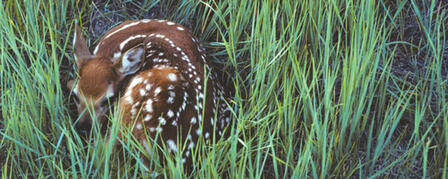SPRINGTIME CAUTION: LEAVE YOUNG WILDLIFE ALONE

Young animals may seem abandoned but are seldom alone in the wild; “rescue,” however, may kill them
PRATT — Spring is a time of rebirth and birth, with trees budding and young wildlife being born and hatched, and different levels of parental care are employed within the animal kingdom, all designed to work without human interference. But one common problem occurs when seemingly abandoned or orphaned wildlife are picked up by well-intentioned persons, often with tragic results.
Mammals such as deer often leave their young to search for food. Deer fawns are born with natural camouflage and little scent, making it difficult for predators to detect them. A spotted coat helps hide young as they sit motionless in surrounding cover. These adaptations make it possible for the doe to move about and feed, maintaining her strength as she provides for her young. Raccoons and other mammals employ similar strategies.
Well-meaning individuals sometimes discover young deer, raccoons, foxes, rabbits, or skunks and assume that they are orphaned or abandoned. Usually, the mother is close at hand but out of sight waiting for the human intruders to leave the area. In this situation, it is extremely important to leave the animals as found in the wild. To pick them up and take them home is illegal, for good reason. Wild animals often have very specific dietary requirements and often die under human care. Those that do survive have little chance of surviving if returned to the wild.
Another reason to avoid picking up wild animals is health. Wild animals carry diseases and parasites that can infect humans or their pets. Dogs, if not vaccinated, may contract distemper from infected coyotes, foxes, or even weasels. Bobcats can transmit a similar disease to domestic cats. Ticks from host animals can expose humans to Lyme disease, and perhaps the greatest danger wild animals pose to humans is rabies. Many animals can carry rabies for several days without showing any outward symptoms.
Pet dogs and cats should also be restrained during the season when young birds, rabbits, and other wildlife are young. Both dogs and cats can be deadly to wild young, no matter how friendly they may seem to humans.
It can be a wonderful experience to see young animals in the wild, but for the benefit of the wildlife, it is important to leave them in the wild, where they are best equipped to survive.
-30-









